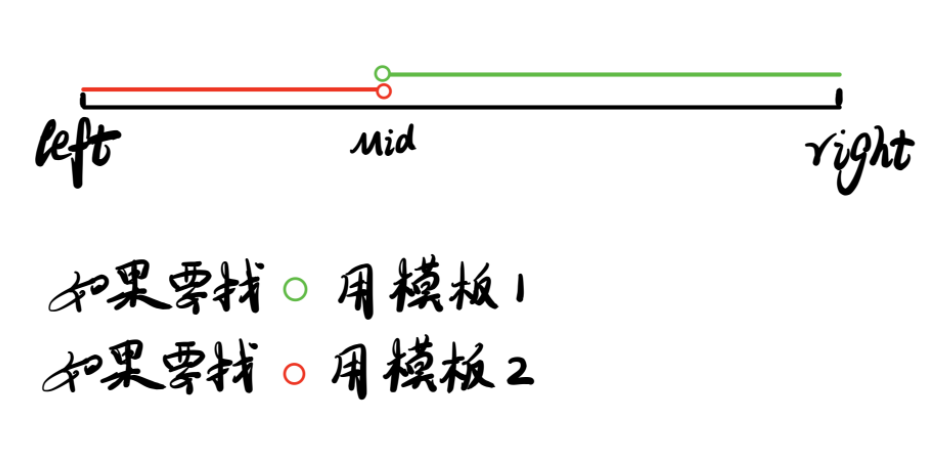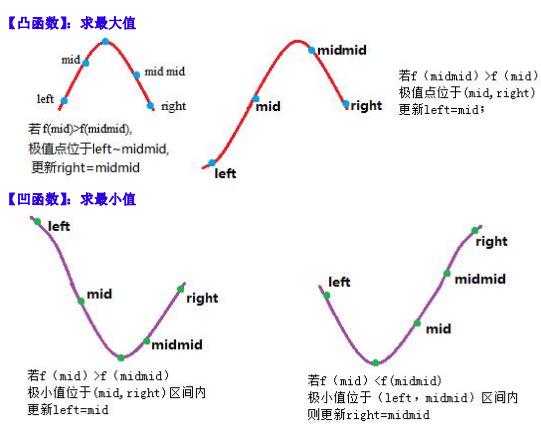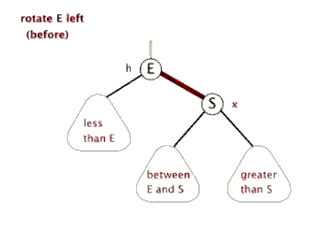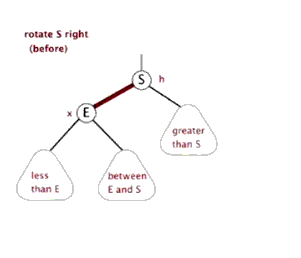一切的开始 1 2 3 4 5 6 7 8 9 10 11 12 13 14 15 16 17 18 19 20 21 22 #include <bits/stdc++.h> using namespace std ;#define pii pair<int,int> #define pll pair<ll,ll> #define pdd pair<double,double> #define fastIO ios::sync_with_stdio(false);cin.tie(0); #define endl "\n" typedef long long ll;const int INF=0x3f3f3f3f ;const int MAXN=5e5 +7 ;const long long MOD=998244353 ;const double pi=acos (-1 );const double eps=1e-4 ;vector <int >di = {-1 , 1 , 0 , 0 }, dj = {0 , 0 , -1 , 1 };int main () return 0 ;
基础 离散化 int C[MAXN], L[MAXN];memcpy (C, A, sizeof (A)); int l = unique(C, C + n) - C; for (int i = 0 ; i < n; ++i)1 ;
三分 while (r - l > eps)2 ;double fl = f(mid - eps), fr = f(mid + eps);if (fl < fr)else
二分 整数集合上的二分:
1 2 3 4 5 6 7 8 9 10 11 12 13 14 15 16 17 18 19 20 21 22 23 24 25 26 27 28 29 30 31 32 bool check (int mid) return ...;int bsearch_1 (int l, int r) while (l < r)int mid = l + r >> 1 ;if (check(mid)) r = mid; else l = mid + 1 ;return l;int bsearch_2 (int l, int r) while (l < r)int mid = l + r + 1 >> 1 ;if (check(mid)) l = mid;else r = mid - 1 ;return l;
实数域上的二分:
$eps=10^{-(k+2)}$ $k=保留小数k位$
bool check (double x) double bsearch_3 (double l, double r) const double eps = 1e-6 ; while (r - l > eps)double mid = (l + r) / 2 ;if (check(mid)) r = mid;else l = mid;return l;
实数域上的三分:
double f (double a) double three (double l,double r) while (l<r-1 )double mid=(l+r)/2 ;double mmid=(mid+r)/2 ;if (f(mid)>f(mmid)) r=mmid;else l=mid;if (f(l)>f(r)) return l;else return r;
数学 整除分块 int ans = 0 ;int k = 10 ;for (int l=1 ,r;l<=k;l=r+1 )if (k / l != 0 )else r = k;1 );
这里和上一个模板的改变是:将连续的$\lfloor 10/i\rfloor$数值相等区间前的系数$i$ 用等差数列求和快速求出。相当于每一段多了一个系数。
int ans = 0 ;int k = 10 ;for (int l=1 ,r;l<=k;l=r+1 )if (k / l != 0 )else r = k;1 )*(l + r) / 2 ;
上下取整的转换技巧 上取整函数建议自己写 :
if (temp%k == 0 )else 1 ;-1 )/ k;
转换技巧: 有时候需要我们做整除分块,将上整除转换为下整除
Lucas定理 1 2 3 4 5 6 7 8 9 10 11 12 13 14 15 16 17 18 19 20 21 22 23 24 25 26 27 28 29 30 31 32 33 34 35 36 37 38 39 40 41 42 43 44 45 46 47 ll n, m, p;ll Ext_gcd (ll a, ll b, ll &x, ll &y) if (b == 0 ) { x = 1 , y = 0 ; return a; }return ret;ll Inv (ll a, int m) if (d == 1 ) return (x%t + t) % t;return -1 ;ll Cm (ll n, ll m, ll p) 1 , b = 1 ;if (m > n) return 0 ;while (m)return (ll)a*Inv(b, p) % p; int Lucas (ll n, ll m, ll p) if (m == 0 ) return 1 ;return (ll)Cm(n%p, m%p, p)*(ll)Lucas(n / p, m / p, p) % p;int main () int T;cin >> T;while (T--)scanf ("%lld%lld%lld" , &n, &m, &p);printf ("%d\n" , Lucas(n, m, p));return 0 ;
lcm/gcd ll gcd (ll a,ll b) return b==0 ?a:gcd(b,a%b);ll lcm (ll a,ll b) return a*(b/gcd(a,b));
预处理阶乘+排列组合+逆元(预处理逆元) 1 2 3 4 5 6 7 8 9 10 11 12 13 14 15 16 17 18 19 20 21 22 23 24 25 26 27 28 29 30 31 32 33 34 35 36 37 38 39 40 41 42 43 ll fac[MAXN];ll ksm (ll n,ll x,ll p=MOD) 1 ;while (x)if (x&1 ) ans=ans*1l l*n%p;1l l*n%p;1 ;return ans;void cal (ll range) 0 ] = 1 ;1 ;for (ll i=1 ;i<=range;i++) {ans = (ans*1l l*i)%MOD;fac[i] = ans;}-2 ,MOD);for (ll i=range-1 ;i>=0 ;i--) {facinv[i] = facinv[i+1 ]*(i+1 )%MOD;}ll ccc (ll x,ll y) return ans;ll aaa (ll x,ll y) 1 ;for (ll i=1 ;i<=y;i++)1l l*y+1l l*i-1 )%MOD;return ans;
线性筛/欧拉筛 int primes[maxn / 10 ];bool isPrime[maxn + 5 ];int tot=0 ;void init () for (int i = 2 ; i <= maxn; i++){if (!isPrime[i]) primes[tot++] = i;for (int j = 0 ; i * primes[j] <= maxn; j++){1 ;if (i % primes[j] == 0 ) break ;
STL 基础 1 2 3 4 5 6 7 8 9 10 11 12 13 14 15 16 17 18 19 20 21 22 23 24 25 26 27 28 29 30 31 32 33 34 35 36 37 38 39 40 41 42 43 44 45 46 47 48 49 50 51 52 53 54 55 56 57 58 59 60 61 62 63 64 65 66 67 68 69 70 71 72 73 74 75 76 77 78 79 80 81 82 83 84 85 86 87 88 89 90 91 92 93 94 95 96 97 98 99 100 vector, 变长数组,倍增的思想() 返回元素个数() 返回是否为空() 清空() /back() _back() /pop_back() begin () /end () [] int , int >string ,字符串() /length() 返回字符串长度() () _str() 返回字符串所在字符数组的起始地址() () () 向队尾插入一个元素() 返回队头元素() 返回队尾元素() 弹出队头元素() () () 插入一个元素() 返回堆顶元素() 弹出堆顶元素int , vector<int >, greater<int >> q;() () () 向栈顶插入一个元素() 返回栈顶元素() 弹出栈顶元素() () () () /back() _back() /pop_back() _front() /pop_front() begin () /end () [] () () () begin () /end () O(logn ) () 插入一个数() 查找一个数() 返回某一个数的个数() 1 ) 输入是一个数x,删除所有x O(k + logn ) 2 ) 输入一个迭代器,删除这个迭代器_bound() /upper_bound() _bound(x ) 返回大于等于x的最小的数的迭代器_bound(x ) 返回大于x的最小的数的迭代器() 插入的数是一个pair() 输入的参数是pair或者迭代器() [] 注意multimap不支持此操作。 时间复杂度是 O(logn ) _bound() /upper_bound() O(1) _bound() /upper_bound() , 迭代器的++,--10000 > s;|, ^ >>, << == , != [] count() 返回有多少个1 any() 判断是否至少有一个1 none() 判断是否全为0 set() 把所有位置成1 set(k, v) 将第k位变成v reset() 把所有位变成0 flip() 等价于~ flip(k) 把第k位取反
lower_bound/upper_bound 设我们有一个数x,并保证a数组从小到大 排好
upper_bound( a,a+n,x):从数组的begin位置到end-1位置二分查找第一个大于x的数字,找到返回该数字的地址,不存在则返回end。通过返回的地址减去起始地址begin,得到找到数字在数组中的下标。
lower_bound( a,a+n,x):从数组的begin位置到end-1位置二分查找第一个大于或等于x的数字,找到返回该数字的地址,不存在则返回end。通过返回的地址减去起始地址begin,得到找到数字在数组中的下标。
在数组a[5]={0,2,3,4,5}中,对于需要查找的x=2
lower_bound(a,a+n,x)-a 返回值为1,表示数组中第一个大于等于x的下标值
upper_bound(a,a+n,x)-a 返回值为2,表示数组中第一个大于x的下标值
上面是对于非递减数列的用法,那对于非递增数列的用法呢?()$ 其中TYPE是指数组类型找不到会返回a.end()/a[n+1]
unorder_map防止被卡O(n)写法 不同于map的红黑树实现,unorder_map的有hash实现,一般来说查找是O(1)的,而不是O(log)的,但是CF上有时会被hack成O(n)的,因此提出这种写法。
1 2 3 4 5 6 7 8 9 10 11 12 13 14 15 16 17 18 19 20 21 22 struct my_hash {static uint64_t splitmix64 (uint64_t x) 0x9e3779b97f4a7c15 ;30 )) * 0xbf58476d1ce4e5b9 ;27 )) * 0x94d049bb133111eb ;return x ^ (x >> 31 );size_t operator () (uint64_t x) const static const uint64_t FIXED_RANDOM =return splitmix64(x + FIXED_RANDOM);size_t operator () (pair<uint64_t , uint64_t > x) const static const uint64_t FIXED_RANDOM =return splitmix64(x.first + FIXED_RANDOM) ^1 );
写完自定义的哈希函数后,就可以通过 unordered_map<int, int, my_hash> my_map; 或者 unordered_map<pair<int, int>, int, my_hash> my_pair_map; 的定义方式将自定义的哈希函数传入容器了。
map自定义排列顺序: 1 2 3 4 5 6 7 8 9 10 11 12 13 14 15 16 17 18 19 20 21 22 23 24 25 26 27 28 #include <bits/stdc++.h> using namespace std ;struct Node {int x,y;int x,int y):x(x),y(y) {}bool operator < (const Node &rhs) const {return x < rhs.x;map <Node,int >mp;int main () int x1,y1;while (cin >>x1>>y1) {if (x1 == 0 && y1 == 0 ) break ;if (!mp.count(temp)) {1 ;else mp[temp]++;for (auto &u:mp) {cout <<u.first.x<<" " <<u.first.y<<" " <<u.second<<endl ;return 0 ;
set自定义顺序 set是一种关联式容器,所以有顺序,下面给出自定义顺序写法。
struct cmp {bool operator () (int a, int b) return a > b; }set <int , cmp> s;
数据结构 ST表 1 2 3 4 5 6 7 8 9 10 11 12 13 14 15 16 17 18 19 20 21 22 23 24 25 26 27 struct RMQ {22 ][MAXN],f2[22 ][MAXN];inline int highbit (ll x) return 31 - __builtin_clz(x);}void init (ll *v,int n) for (int i = 0 ;i < n;i++) f1[0 ][i] = f2[0 ][i]= v[i];for (int x = 1 ;x <= highbit(n);x++)for (int i = 0 ;i <= n - (1 << x);i++) {min (f1[x - 1 ][i],f1[x - 1 ][i + (1 << (x - 1 ))]);max (f2[x - 1 ][i],f2[x - 1 ][i + (1 << (x - 1 ))]);ll get_min (int l,int r) {int t = highbit(r - l + 1 );return min (f1[t][l],f1[t][r - (1 << t) + 1 ]);ll get_max (int l,int r) {int t = highbit(r - l + 1 );return max (f2[t][l],f2[t][r - (1 << t) + 1 ]);int array []....array ,n);
单调队列 复杂度O(n)
在长度为n的序列中求每个长度为m的区间最值
deque <int > Q; for (int i = 0 ; i < n; ++i)if (!Q.empty() && i - Q.front() >= m) while (!Q.empty() && V[Q.back()] < V[i]) if (i >= m - 1 )cout << V[Q.front()] << " " ;
单调栈 求NGE(Next greater element)问题。
1 2 3 4 5 6 7 8 9 10 11 12 13 14 15 16 17 int n;cin >> n;for (int i = 1 ; i <= n; ++i)cin >> V[i];stack <int > S;for (int i = 1 ; i <= n; ++i)while (!S.empty() && V[S.top()] < V[i])for (int i = 1 ; i <= n; ++i)cout << ans[i] << " " ;
线段树 单点修改+区间查询
1 2 3 4 5 6 7 8 9 10 11 12 13 14 15 16 17 18 19 20 21 22 23 24 25 26 27 28 29 30 31 32 33 34 35 36 37 38 39 40 struct Node {int l,r;int v;4 *MAXN];void pushup (int u) max (tr[u<<1 ].v,tr[u<<1 |1 ].v);void build (int u,int l,int r) if (l==r) return ;int mid = l + r >> 1 ;1 ,l,mid);1 |1 ,mid+1 ,r);int query (int u,int l,int r) if (tr[u].l>=l&&tr[u].r<=r) return tr[u].v;int mid = tr[u].l + tr[u].r >> 1 ;int v = 0 ;if (l<=mid) v = query(u<<1 ,l,r);if (l>mid) v = max (v,query(u<<1 |1 ,l,r));return v;void modify (int u,int x,int v) if (tr[u].l==x&&tr[u].r==x) tr[u].v = v;else int mid = tr[u].l + tr[u].r >> 1 ;if (x<=mid) modify(u<<1 ,x,v);else modify(u<<1 |1 ,x,v);
区间修改+区间查询:
1 2 3 4 5 6 7 8 9 10 11 12 13 14 15 16 17 18 19 20 21 22 23 24 25 26 27 28 29 30 31 32 33 34 35 36 37 38 39 40 41 42 43 44 45 46 47 48 49 50 51 52 53 54 55 56 57 58 59 60 61 62 63 64 65 66 67 68 69 70 71 72 73 74 75 76 77 78 79 80 81 82 83 84 85 86 87 88 89 90 91 92 typedef long long ll;const int INF=0x3f3f3f3f ;const int MAXN=5e5 +2 ;const int MOD=998244353 ;const double pi=acos (-1 );const double eps=1e-4 ;int w[MAXN];struct Node {int l,r;4 *MAXN];void pushup (int u) 1 ].sum + tr[u<<1 |1 ].sum;void pushdown (int u) auto &root = tr[u], &left = tr[u<<1 ], &right = tr[u<<1 |1 ];if (root.add)1 )*root.add;1 )*root.add;0 ;void build (int u,int l,int r) if (l==r) tr[u] = {l,r,w[r],0 };else int mid = l+r>>1 ;1 ,l,mid);1 |1 ,mid+1 ,r);void modify (int u,int l,int r,int d) if (tr[u].l>=l&&tr[u].r<=r)1 )*d;else int mid = tr[u].l + tr[u].r>>1 ;if (l<=mid) modify(u<<1 ,l,r,d);if (r>mid) modify(u<<1 |1 ,l,r,d);ll query (int u,int l,int r) if (tr[u].l>=l&&tr[u].r<=r) return tr[u].sum;int mid = tr[u].l + tr[u].r>>1 ;0 ;if (l<=mid) sum += query(u<<1 ,l,r);if (r>mid) sum += query(u<<1 |1 ,l,r);return sum;int main () int n,m;cin >>n>>m;for (int i=1 ;i<=n;i++) cin >>w[i];1 ,1 ,n);char op[2 ];int l,r,d;while (m--)cin >>op>>l>>r;if (*op=='C' )cin >>d;1 ,l,r,d);else cout <<query(1 ,l,r)<<endl ;return 0 ;
Trie树 1 2 3 4 5 6 7 8 9 10 11 12 13 14 15 16 17 18 19 20 21 22 23 24 25 26 27 28 29 30 int son[N][26 ], cnt[N], idx;void insert (char *str) int p = 0 ;for (int i = 0 ; str[i]; i ++ )int u = str[i] - 'a' ;if (!son[p][u]) son[p][u] = ++ idx;int query (char *str) int p = 0 ;for (int i = 0 ; str[i]; i ++ )int u = str[i] - 'a' ;if (!son[p][u]) return 0 ;return cnt[p];
并查集 朴素并查集:
1 2 3 4 5 6 7 8 9 10 11 12 13 14 15 16 17 18 19 20 21 22 23 24 25 26 27 28 29 30 31 32 33 34 35 36 37 38 39 40 41 42 43 int p[N]; int find (int x) if (p[x] != x) p[x] = find (p[x]);return p[x];for (int i = 1 ; i <= n; i ++ ) p[i] = i;find (a)] = find (b);void unite (int x,int y) find (x);find (y);if (x==y) return ;if (rank[x]<rank[y])else if (rank[x]==rank[y]) rank[x]++;int find (int x) int p=x;while (p!=fa[p])while (x!=p){int tmp=fa[x];return x;
维护size的并查集:
1 2 3 4 5 6 7 8 9 10 11 12 13 14 15 16 17 18 19 20 int p[N], size [N];int find (int x) if (p[x] != x) p[x] = find (p[x]);return p[x];for (int i = 1 ; i <= n; i ++ )size [i] = 1 ;size [find (b)] += size [find (a)];find (a)] = find (b);
维护到祖宗节点距离的并查集:
1 2 3 4 5 6 7 8 9 10 11 12 13 14 15 16 17 18 19 20 21 22 23 24 25 int p[N], d[N];int find (int x) if (p[x] != x)int u = find (p[x]);return p[x];for (int i = 1 ; i <= n; i ++ )0 ;find (a)] = find (b);find (a)] = distance;
树状数组 单点修改+区间查询:
1 2 3 4 5 6 7 8 9 10 11 12 13 14 15 16 17 18 19 20 21 22 23 24 25 26 27 28 29 30 int n;int tree[MAXN];int a[MAXN];int lowbit (int x) return x&(-x);}int getsum (int x) int ans_tep=0 ;for (int i=x;i>0 ;i-=lowbit(i)) ans_tep+=tree[i];return ans_tep;void single_update (int x,int y) for (int i=x;i<=n;i+=lowbit(i)) tree[i]+=y;int range_query (int x,int y) return getsum(y)-getsum(x-1 );int main () scanf ("%d" ,&n);for (int i=1 ;i<=n;i++)scanf ("%d" ,&a[i]);int x,int y)int x)return 0 ;
区间修改+单点查询:
1 2 3 4 5 6 7 8 9 10 11 12 13 14 15 16 17 18 19 20 21 22 23 24 25 26 27 28 29 30 31 32 int n;int a[MAXN];int tree_help[MAXN];int lowbit (int x) return x&(-x);}void part_update (int x,int val) for (int i=x;i<=n;i+=lowbit(i)) tree_help[i]+=val;void update_query (int l,int r,int val) 1 ,-val);int single_query (int x) int ans_tep=0 ;for (int i=x;i>0 ;i-=lowbit(i)) ans_tep+=tree_help[i];return ans_tep;int main () scanf ("%d" ,&n);for (int i=1 ;i<=n;i++)scanf ("%d" ,&a[i]);-1 ]);int l,int r,int val);int x);return 0 ;
区间修改+区间查询:
1 2 3 4 5 6 7 8 9 10 11 12 13 14 15 16 17 18 19 20 21 22 23 24 25 26 27 28 29 30 31 32 33 34 35 36 37 38 39 40 41 42 43 44 45 46 47 48 49 50 51 52 53 54 55 56 57 58 59 60 61 62 63 64 65 66 67 68 #include <bits/stdc++.h> using namespace std ;#define pii pair<int,int> #define pll pair<ll,ll> #define pdd pair<double,double> typedef long long ll;const int INF=0x3f3f3f3f ;const int MAXN=5000 +5 ;const int MOD=1e9 +7 ;const double pi=cos (-1 );int n;int a[MAXN];int c1[MAXN],c2[MAXN];int lowbit (int x) return x&(-x);}void update (int *o,int x,int val) for (int i=x;i<=n;i++)int getsum (int *o,int x) int ans_tep=0 ;for (int i=x;i>0 ;i-=lowbit(x))return ans_tep;int sum (int x) int ans1_tep,ans2_tep;return ans1-ans2;int range_quiry (int l,int r) int ans1_tep,ans2_tep;-1 );return ans1_tep-ans2_tep;int update_range (int l,int r,int val) 1 ,-val);-1 )*val);1 ,-r*val);int main () scanf ("%d" ,&n);for (int i=1 ;i<=n;i++)scanf ("%d" ,&a[i]);-1 ]);-1 )*(a[i]-a[i-1 ]));int l,int r,int val)int l,int r);return 0 ;
平衡树AVL
1 2 3 4 5 6 7 8 9 10 11 12 13 14 15 16 17 18 19 20 21 22 23 24 25 26 27 28 29 30 31 32 33 34 35 36 37 38 39 40 41 42 43 44 45 46 47 48 49 50 51 52 53 54 55 56 57 58 59 60 61 62 63 64 65 66 67 68 69 70 71 72 73 74 75 76 77 78 79 80 81 82 83 84 85 86 87 88 89 90 91 92 93 94 95 96 #include <bits/stdc++.h> using namespace std ;#define pii pair<int,int> #define pll pair<ll,ll> #define pdd pair<double,double> #define fastIO ios::sync_with_stdio(false);cin.tie(0); #define fi first #define se second typedef long long ll;const int INF=0x3f3f3f3f ;const int MAXN=5e5 +2 ;const int MOD=998244353 ;const double pi=acos (-1 );const double eps=1e-4 ;int n;struct node { int data;node *Newnode (int x) new node;nullptr ;return newnode;int height (node *root) if (root==nullptr ) return 0 ;else return max (height (root->lchild),height (root->rchild)) + 1 ;int getbalance (node* root) return height (root->lchild) - height (root->rchild);void R (node*&root) void L (node*&root) void inst (node* &root,int x) if (root==nullptr )return ;if (x<root->data)if (getbalance(root)==2 )if (getbalance(root->lchild)==1 ) R(root);else if (getbalance(root->lchild)==-1 ) {L(root->lchild);R(root);}else if (getbalance(root)==-2 )if (getbalance(root->rchild)==1 ) {R(root->rchild);L(root);}else if (getbalance(root->rchild)==-1 ) L(root);int main () cin >>n;nullptr ;for (int i=0 ;i<n;i++)int x;cin >>x;cout <<root->data<<endl ;return 0 ;
图论 最短路 Dijkstra(单源最短路,正边权):
无优化:
1 2 3 4 5 6 7 8 9 10 11 12 13 14 15 16 17 18 19 20 21 22 23 24 25 26 27 int g[N][N]; int dist[N]; bool st[N]; int dijkstra () memset (dist, 0x3f , sizeof dist);1 ] = 0 ;for (int i = 0 ; i < n - 1 ; i ++ )int t = -1 ;for (int j = 1 ; j <= n; j ++ )if (!st[j] && (t == -1 || dist[t] > dist[j]))for (int j = 1 ; j <= n; j ++ )min (dist[j], dist[t] + g[t][j]);true ;if (dist[n] == 0x3f3f3f3f ) return -1 ;return dist[n];
1 2 3 4 5 6 7 8 9 10 11 12 13 14 15 16 17 18 19 20 21 22 23 24 25 26 27 28 29 30 31 32 33 34 35 36 37 38 39 40 41 42 43 44 45 46 47 48 49 50 51 52 53 54 55 56 57 58 59 60 61 62 63 64 65 66 67 68 #include <bits/stdc++.h> using namespace std ;#define pii pair<int,int> #define pll pair<ll,ll> #define pdd pair<double,double> #define fastIO ios::sync_with_stdio(false);cin.tie(0); typedef long long ll;const int INF=0x3f3f3f3f ;const int MAXN=5e5 +2 ;const int MOD=998244353 ;const double pi=acos (-1 );const double eps=1e-4 ;int n,m;int dist[MAXN];bool st[MAXN];vector <int >g[MAXN];map <pii,int >w;void dij (int src) memset (dist,0x3f ,sizeof dist);0 ;vector <pii>,greater<pii>>heap;0 ,src});while (!heap.empty())auto t = heap.top();int u = t.second,distance = t.first;if (st[u]) continue ;else st[u] = true ;for (int i=0 ;i<g[u].size ();i++)int v = g[u][i];if (dist[v]>distance+w[{u,v}])int main () cin >>n>>m;for (int i=1 ;i<=m;i++)int x,y,z;cin >>x>>y>>z;1 );if (dist[n]==0x3f3f3f3f ) cout <<-1 <<endl ;else cout <<dist[n]<<endl ;return 0 ;
SPFA(单源最短路,正负边权皆可):
1 2 3 4 5 6 7 8 9 10 11 12 13 14 15 16 17 18 19 20 21 22 23 24 25 26 27 28 29 30 31 32 33 34 35 36 37 38 39 #define N 100005 struct edge { int v,w,nxt;2 ];void add (int u,int v,int w) queue <int > Q;bool vis[M];void SPFA (int s) memset (dis,0x3F ,sizeof (dis));0 ;1 ;while (!Q.empty())int u=Q.front();0 ;for (int i=head[u]; i; i=e[i].nxt)if (dis[u]+e[i].w<dis[e[i].v])if (!vis[e[i].v])1 ;
Floyd $O(n^3)$
初始化:for (int i = 1 ; i <= n; i ++ )for (int j = 1 ; j <= n; j ++ )if (i == j) d[i][j] = 0 ;else d[i][j] = INF;void floyd () for (int k = 1 ; k <= n; k for (int i = 1 ; i <= n; i ++ )for (int j = 1 ; j <= n; j ++ )min (d[i][j], d[i][k] + d[k][j]);
DP 排序 手写堆 1 2 3 4 5 6 7 8 9 10 11 12 13 14 15 16 17 18 19 20 21 22 23 24 25 26 27 28 29 30 31 32 33 34 35 36 37 38 39 40 41 42 43 44 45 46 47 #include <bits/stdc++.h> using namespace std ;#define pii pair<int,int> #define pll pair<ll,ll> #define pdd pair<double,double> #define fastIO ios::sync_with_stdio(false);cin.tie(0); typedef long long ll;const int INF=0x3f3f3f3f ;const int MAXN=5e5 +2 ;const int MOD=998244353 ;const double pi=acos (-1 );const double eps=1e-4 ;int a[11 ] = {0 ,10 ,5 ,13 ,14 ,1 ,23 ,44 ,1 ,22 ,23 };void adjust (int n,int i) int largest = i;if (i*2 <=n&&a[largest]<a[i*2 ]) largest = i*2 ;if (i*2 +1 <=n&&a[largest]<a[i*2 +1 ]) largest = i*2 +1 ;if (largest!=i)int main () int n = 10 ;for (int i=n/2 ;i>=1 ;i--)for (int i=n;i>=1 ;i--)1 ],a[i]);-1 ,1 );for (int i=1 ;i<=n;i++) cout <<a[i]<<" " ;cout <<endl ;return 0 ;
奇怪的知识
对于小于n的所有素数$p$,$\sum 1/p=loglogn$
对于小于n的所有正整数$x$,$\sum 1/x = logn$,也就是调和级数
无极鲅鱼
请检查是否应该开long long
每个test case清空数组的时候应当大一些,比如清空1到n的时候,请尝试清楚1到n+1,因为上一个test case的n+1可能会影响到这一次的结果。
#pragma comment(linker, "/STACK:10240000000000,10240000000000") 手动开栈再读一边题目,是否读错了题目。
自定义比较函数别用<= 最好定义<
endl太慢,用"\n" 或者 #define endl "\n"



